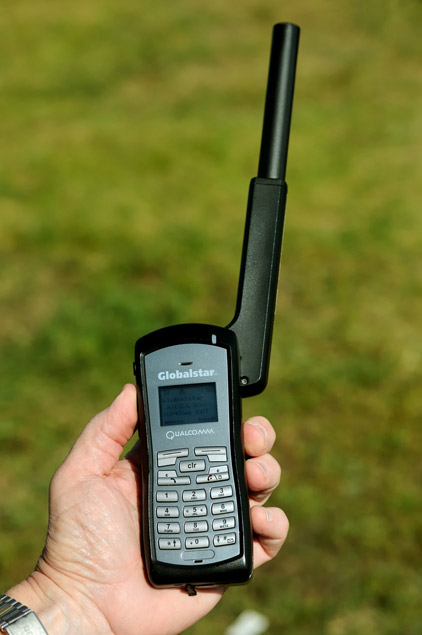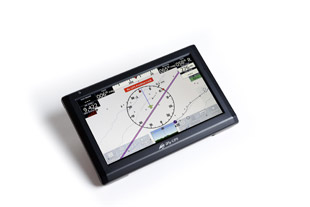Globalstar entry smaller, economical
By Mike Collins
 Globalstar, which provides mobile satellite voice and data services—and which owns the SPOT tracking, satellite messaging, and emergency notification service popular with many pilots—is poised to become a bigger player in the general aviation community.
Globalstar, which provides mobile satellite voice and data services—and which owns the SPOT tracking, satellite messaging, and emergency notification service popular with many pilots—is poised to become a bigger player in the general aviation community.
The company is entering the aviation communications market, pairing Globalstar’s GSP-1700 satellite phone and the Globalstar Sat-Fi satellite hotspot with a new aviation antenna. STC approval of the antenna and phone cradle is pending, which Globalstar anticipates by mid October with deliveries in late October, said Elliott Borenstein, Globalstar’s aviation products manager. The phone itself is portable and does not require approval—and it gives an aircraft owner flexibility, he added, because it can be used internationally where cellphones may not work.
Globalstar’s satellites, launched in 2013, feature second-generation technology. “That gives us a speed advantage that nobody will be able to touch for at least five years,” Borenstein said. The satellites’ data rate is 9.6 kbps and by early next year, Globalstar will complete the upgrade of many of its gateways to 256 kbps—25 times faster than the current rate. Antenna size is a limiting factor and typical GA users will reliably have speeds of 36 kbps to 72 kbps. The network supports voice calls, texts, Email, and weather updates.
The GSP-1700 Mobile Satellite Phone is the smallest and most affordable satellite phone available for retail purchase, according to Globalstar—and currently the phone itself is free with a subscription to select airtime plans. Plans begin at $39.99 per month for 40 minutes of service, and range to an unlimited plan for $149.99 per month. The phone is free with the 100-minute plan, priced at $64.99 per month, and higher plans. Borenstein added that “pilot-friendly” seasonal plans allow minutes to be used when needed—for example, during the flying season or on a long trip. Installed weight is estimated at two pounds.
Globalstar’s Sat-Fi satellite hotspot allows customers to connect any Wi-Fi-enabled device to the satellite data network. It can support up to eight devices simultaneously. The hardware is priced at $999 and also requires a subscription. Coverage includes North and South America, Europe, and Australia; there are no roaming charges in North America or Europe.
Email [email protected]
Web: www.globalstar.com/aviation
NASA opts for satellite tracking
Globalstar Inc. has partnered with ADS-B Technologies, LLC, to develop a satellite-based ADS-B technology. Its ADS-B Link Augmentation System (ALAS) piggybacks off an existing 1090ES or 978UAT ADS-B transceiver and provide that data via satellite for flight tracking. The company said the technology works in places where there are known gaps in flight tracking ability, like the Gulf of Mexico.
In August NASA chose ALAS for two-way communications requirements relative to ongoing R&D work at the Langley Research Center, where it will use two-way voice and data communications over the Globalstar satellite network. The system is compatible with and complementary to existing Globalstar services the facility purchased previously, Globalstar said.
The company recently completed an ALAS test flight across Canada, most of which is not covered by radar or ground-based ADS-B. A 7,000-mile demonstration from Alaska to the Gulf of Mexico and back was completed in September 2014.
“With the additional 36 hours from our recent trans-Canada flight, we now have almost 100 flight hours of data demonstrating ALAS performance reporting aircraft position every second during a flight,” said Skip Nelson, president of ADS-B Technologies. “ALAS is also a more secure form of ADS-B, since the nature of the L-band [satellite] transmission and the antenna pattern make the aircraft’s ADS-B position reports virtually impossible to intercept, jam, or deceive.”
The system is a simple peripheral that couples to the coax leading to either the top or bottom antenna on any 1090ES or 978UAT system, and transmits the data over a low-drag satcom antenna, Nelson said. Normal aircraft-to-ground ADS-B transmissions are not affected. “The latest version of the system also has an optional tamper-proof backup module that will step in and continue to transmit an ADS-B payload for about 10 hours, should the aircraft’s normal ADS-B systems be interrupted.”
Nelson said they’ve successfully tested simultaneous one-second ADS-B reports and datacom over the same antenna and in the same pilot-to-controller two-second timeframe—in other words, the controller transmits an instruction and immediately sees the aircraft complying. “We think this low-latency capability will become a key element in satellite-augmented critical services, as opposed to mere aircraft tracking, someday.” —MPC
Fly Mechanic
Fly Mechanic is a rating system for technicians and repair stations. It empowers users to speak honestly about their experiences with a particular repair or alteration. Co-founder Andrew LaFollette said he was burned a number of times with repairs on an airplane he was flying professionally. That’s when he and a friend decided there had to be a better way to source a mechanic. The site includes every repair station in the country, and many independent technicians as well. Users can search by airport, aircraft type, or the type of work that needs to be done. Currently there are more than 5,000 shops and almost 800 reviews. LaFollette says the reviews are upfront. Companies can’t tamper with them, and can only gain better visibility through paid advertising. Both searching and posting are free for users. —Ian J. Twombly
Adventure Pilot’s iFly
 What once was a vibrant business of new handheld GPS units has all but evaporated, thanks to tablets. Adventure Pilot’s iFly is one of the holdouts, and according to them, customers are thankful for it. The new iFly 740 is one of the few new purpose-built GPS units left. The 7-inch screen displays sectionals and other charts in beautiful hi resolution. Turn it on, touch on the screen, and a menu pops up. It’s quick and easy to load flight plans, find nav and airport data, and switch between views. It’s very readable in sunlight, and is more than three times as bright as Apple’s iPad. Adventure Pilot has created an iPad app with software that mimics the iFly 740. Buy both and you can mirror one to the other. Change a flight plan on the app and it will send it to the GPS, and so on. The iFly 740 is available for $899, or with street maps for $50 more. Map updates and iPad app subscriptions are extra.—IJT
What once was a vibrant business of new handheld GPS units has all but evaporated, thanks to tablets. Adventure Pilot’s iFly is one of the holdouts, and according to them, customers are thankful for it. The new iFly 740 is one of the few new purpose-built GPS units left. The 7-inch screen displays sectionals and other charts in beautiful hi resolution. Turn it on, touch on the screen, and a menu pops up. It’s quick and easy to load flight plans, find nav and airport data, and switch between views. It’s very readable in sunlight, and is more than three times as bright as Apple’s iPad. Adventure Pilot has created an iPad app with software that mimics the iFly 740. Buy both and you can mirror one to the other. Change a flight plan on the app and it will send it to the GPS, and so on. The iFly 740 is available for $899, or with street maps for $50 more. Map updates and iPad app subscriptions are extra.—IJT

